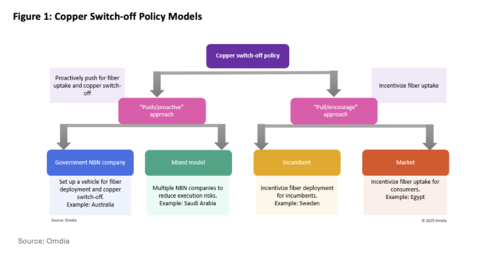Omdia Highlights Importance of End User Awareness in Copper Retirement Process
Omdia's new report on Copper Switch-off Regulations and Policies reveals significant progress in global copper network retirement plans. Estonia, Sweden, Qatar, and UAE have shown notable advancement, with Middle Eastern countries transitioning over 85% of customers to fiber. Singapore achieved complete copper network shutdown in 2018, while Latin America faces ongoing challenges due to regulatory and investment barriers.
The report identifies two main regulatory policy approaches: 'push' model, where countries proactively design policies to replace copper networks (examples: Australia and Saudi Arabia), and 'pull' model, which incentivizes fiber uptake (examples: Sweden and Egypt). Key policy focus areas include promoting infrastructure competition, adjusting wholesale regulation, and ensuring consumer protection.
The report emphasizes the critical importance of end-user awareness, requiring telcos to issue formal notifications about timeframes, replacement products, and pricing terms. Regulators like Ofcom are gradually shifting from copper to fiber network obligations, creating conditions for successful copper network retirement.
Il nuovo rapporto di Omdia sulle normative e politiche di disattivazione del rame rivela progressi significativi nei piani di pensionamento delle reti in rame a livello globale. Estonia, Svezia, Qatar e UAE hanno mostrato notevoli avanzamenti, con i paesi del Medio Oriente che stanno passando oltre l'85% dei clienti alla fibra. Singapore ha completato la disattivazione della rete in rame nel 2018, mentre l'America Latina affronta sfide continue a causa di barriere normative e di investimento.
Il rapporto identifica due principali approcci politici normativi: il modello 'push', in cui i paesi progettano attivamente politiche per sostituire le reti in rame (esempi: Australia e Arabia Saudita), e il modello 'pull', che incentiva l'adozione della fibra (esempi: Svezia ed Egitto). Le aree chiave di attenzione politica includono la promozione della concorrenza infrastrutturale, l'adattamento della regolamentazione all'ingrosso e la garanzia della protezione dei consumatori.
Il rapporto sottolinea l'importanza critica della consapevolezza degli utenti finali, richiedendo ai fornitori di telecomunicazioni di emettere notifiche formali riguardo ai tempi, ai prodotti sostitutivi e ai termini di prezzo. I regolatori come Ofcom stanno gradualmente passando dagli obblighi della rete in rame a quelli della rete in fibra, creando condizioni per un pensionamento di successo della rete in rame.
El nuevo informe de Omdia sobre las regulaciones y políticas de desconexión del cobre revela avances significativos en los planes de jubilación de redes de cobre a nivel mundial. Estonia, Suecia, Qatar y EAU han mostrado un notable progreso, con los países de Oriente Medio que están trasladando más del 85% de los clientes a fibra. Singapur logró la desconexión total de la red de cobre en 2018, mientras que América Latina enfrenta desafíos continuos debido a barreras regulatorias y de inversión.
El informe identifica dos enfoques principales de políticas regulatorias: el modelo 'push', donde los países diseñan proactivamente políticas para reemplazar las redes de cobre (ejemplos: Australia y Arabia Saudita), y el modelo 'pull', que incentiva la adopción de fibra (ejemplos: Suecia y Egipto). Las áreas clave de enfoque de políticas incluyen la promoción de la competencia en infraestructura, el ajuste de la regulación mayorista y la garantía de la protección del consumidor.
El informe enfatiza la importancia crítica de la conciencia del usuario final, exigiendo a las telecomunicaciones emitir notificaciones formales sobre los plazos, productos de reemplazo y términos de precios. Reguladores como Ofcom están cambiando gradualmente de las obligaciones de red de cobre a las de fibra, creando condiciones para una jubilación exitosa de la red de cobre.
Omdia의 새로운 보고서는 구리 스위치 오프 규정 및 정책에 관한 전 세계 구리 네트워크 은퇴 계획에서 중요한 진전을 보여줍니다. 에스토니아, 스웨덴, 카타르 및 아랍에미리트는 주목할 만한 발전을 보였으며, 중동 국가들은 고객의 85% 이상을 광섬유로 전환하고 있습니다. 싱가포르는 2018년에 구리 네트워크의 완전한 종료를 달성했으며, 라틴 아메리카는 규제 및 투자 장벽으로 인해 지속적인 어려움에 직면해 있습니다.
보고서는 두 가지 주요 규제 정책 접근 방식을 식별합니다: '푸시' 모델은 국가가 구리 네트워크를 대체하기 위한 정책을 적극적으로 설계하는 것이고 (예: 호주 및 사우디아라비아), '풀' 모델은 광섬유 채택을 장려하는 것입니다 (예: 스웨덴 및 이집트). 주요 정책 초점 영역에는 인프라 경쟁 촉진, 도매 규제 조정 및 소비자 보호 보장이 포함됩니다.
보고서는 최종 사용자 인식의 중요성을 강조하며, 통신사들이 기간, 대체 제품 및 가격 조건에 대한 공식 통지를 발행해야 한다고 요구합니다. Ofcom과 같은 규제 기관은 구리에서 광섬유 네트워크 의무로 점차 전환하고 있으며, 구리 네트워크 은퇴를 위한 성공적인 조건을 만들고 있습니다.
Le nouveau rapport d'Omdia sur les réglementations et politiques de désactivation du cuivre révèle des progrès significatifs dans les plans de retrait des réseaux de cuivre à l'échelle mondiale. Estonie, Suède, Qatar et Émirats Arabes Unis ont montré des avancées notables, les pays du Moyen-Orient transférant plus de 85 % de leurs clients vers la fibre. Singapour a réalisé l'arrêt complet de son réseau en cuivre en 2018, tandis que l'Amérique latine fait face à des défis continus en raison de barrières réglementaires et d'investissement.
Le rapport identifie deux principaux approches de politiques réglementaires : le modèle 'push', où les pays conçoivent proactivement des politiques pour remplacer les réseaux en cuivre (exemples : Australie et Arabie Saoudite), et le modèle 'pull', qui incite à l'adoption de la fibre (exemples : Suède et Égypte). Les domaines clés d'attention politique comprennent la promotion de la concurrence infrastructurelle, l'ajustement de la réglementation de gros et la garantie de la protection des consommateurs.
Le rapport souligne l'importance critique de la connaissance des utilisateurs finaux, exigeant des opérateurs de télécommunications qu'ils émettent des notifications formelles concernant les délais, les produits de remplacement et les conditions tarifaires. Les régulateurs comme Ofcom passent progressivement des obligations de réseau en cuivre à celles de la fibre, créant des conditions pour un retrait réussi du réseau en cuivre.
Der neue Bericht von Omdia über die Vorschriften und Richtlinien zur Abschaltung von Kupfer zeigt erhebliche Fortschritte bei den globalen Plänen zur Stilllegung von Kupfernetzen. Estland, Schweden, Katar und die VAE haben bemerkenswerte Fortschritte erzielt, wobei die Länder im Nahen Osten über 85% der Kunden auf Glasfaser umstellen. Singapur erreichte 2018 die vollständige Abschaltung des Kupfernetzes, während Lateinamerika aufgrund regulatorischer und investitionsbedingter Hürden weiterhin vor Herausforderungen steht.
Der Bericht identifiziert zwei Hauptansätze für regulatorische Politiken: das 'Push'-Modell, bei dem Länder proaktiv Richtlinien zur Ersetzung von Kupfernetzen entwerfen (Beispiele: Australien und Saudi-Arabien), und das 'Pull'-Modell, das die Glasfaseraufnahme anreizt (Beispiele: Schweden und Ägypten). Wichtige politische Schwerpunktbereiche umfassen die Förderung des Infrastrukturrwettbewerbs, die Anpassung der Großhandelsregulierung und die Gewährleistung des Verbraucherschutzes.
Der Bericht betont die entscheidende Bedeutung des Bewusstseins der Endnutzer, was von den Telekommunikationsanbietern verlangt, formelle Benachrichtigungen über Zeitrahmen, Ersatzprodukte und Preisbedingungen auszustellen. Regulierungsbehörden wie Ofcom verlagern allmählich die Verpflichtungen von Kupfer- auf Glasfasernetze und schaffen Bedingungen für eine erfolgreiche Stilllegung des Kupfernetzes.
- None.
- None.

Copper Switch-off Policy Models
European countries such as
National regulators have adopted various regulatory policy models to govern incumbents switching off their legacy networks that can be broadly classified under two categories: push and pull (Figure 1). Under the push model, countries have been proactively designing policies to replace copper networks, whereas under a pull model, fiber uptake has been incentivized for stakeholders to encourage customer migration so that copper networks can be retired.
“Both approaches have merits in enabling the copper retirement process”, said McBride.
Omdia’s report identifies several policy focus areas aimed at supporting and in some cases, accelerating the migration process. These include promoting infrastructure competition, changes to wholesale regulation, and ensuring consumer protection measures are in place, such as raising end user awareness.
“It is this last piece that is most critical”, said McBride. “Regulators are frequently ensuring that telcos protect consumers, especially vulnerable customers, by obligating them to issue formal notifications to wholesale and retail customers outlining timeframes, replacement products, and pricing terms. This increases transparency and empowers customers to make informed decisions, including early contract terminations if they choose not to migrate”, McBride continued.
Regulators such as Ofcom in the
“This is another key point to emphasize. To enable copper switch-off, it’s essential to transition wholesale obligations from copper to fiber access once sufficient coverage is reached. This is the final step in creating the right conditions for copper networks to be switched off”, said McBride.
ABOUT OMDIA
Omdia, part of Informa TechTarget, Inc. (Nasdaq: TTGT), is a technology research and advisory group. Our deep knowledge of tech markets combined with our actionable insights empower organizations to make smart growth decisions.
View source version on businesswire.com: https://www.businesswire.com/news/home/20250410966012/en/
Fasiha Khan – Fasiha.khan@omdia.com
Source: Omdia





